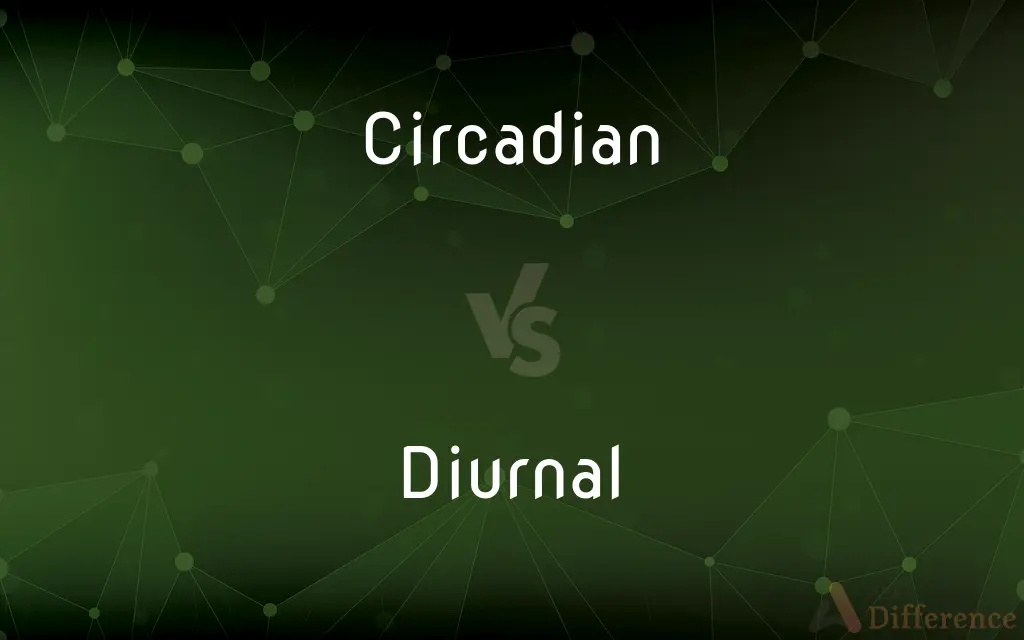Circadian vs. Diurnal — What's the Difference?
Edited by Tayyaba Rehman — By Fiza Rafique — Updated on April 8, 2024
Circadian rhythms are 24-hour cycles affecting biological processes, while diurnal refers to daily activity patterns, especially daylight activity.

Difference Between Circadian and Diurnal
Table of Contents
ADVERTISEMENT
Key Differences
Circadian rhythms are internal, roughly 24-hour cycles that regulate various biological processes in living organisms, including sleep-wake cycles, hormone release, and body temperature. These rhythms are endogenously generated and can persist in the absence of external cues, although they are often synchronized to the 24-hour day by environmental factors such as light and temperature. On the other hand, diurnal refers to the behavior of organisms that are active during the day and inactive at night, contrasting with nocturnal behavior.
While circadian rhythms influence a wide array of physiological and behavioral processes and are found in nearly all living organisms, including plants and microorganisms, the term "diurnal" specifically describes the timing of an organism's activity. Therefore, a diurnal animal's activity pattern may be governed by its circadian rhythm, but the concept of diurnality focuses on the observable pattern of activity, not the underlying biological mechanisms.
Circadian rhythms are crucial for maintaining homeostasis and optimizing the timing of physiological processes to align with environmental cycles. For example, the human circadian rhythm regulates the sleep-wake cycle, ensuring that physiological processes are optimally timed for rest or activity. In contrast, diurnality as a behavioral pattern has evolved in various animals, including humans, for reasons that may include avoiding predators that are more active at night or optimizing foraging efficiency during daylight hours.
Understanding circadian rhythms has significant implications for health and medicine, as disruptions to these rhythms (such as those caused by shift work or jet lag) can have profound effects on physical and mental health. Diurnal patterns, while also important, are more descriptive of behavior and do not carry the same direct physiological implications, although they are shaped by evolutionary pressures and environmental interactions.
Circadian rhythms are regulated by a complex system of genes and proteins that produce oscillations in cellular function and organismal behavior. These biological clocks are influenced by external zeitgebers (time-givers), such as light and temperature, which help synchronize circadian rhythms with the external environment. In contrast, diurnality is a simpler concept referring to the timing of activity and does not involve the underlying genetic and biochemical mechanisms that drive circadian rhythms.
ADVERTISEMENT
Comparison Chart
Definition
Pertains to biological processes that occur in a roughly 24-hour cycle.
Refers to organisms that are active during the day and rest at night.
Scope
Applies to physiological and behavioral processes in almost all living organisms.
Specifically describes the daily activity pattern of organisms.
Regulation
Internally generated but can be influenced by environmental cues.
Determined by environmental light and darkness, but not regulated by an internal clock.
Health Implications
Disruptions can affect physical and mental health.
Mainly affects behavioral patterns, with less direct impact on health.
Examples
Sleep-wake cycles, hormone release, body temperature regulation.
Humans, many birds, and some species of insects and mammals that are active during daylight.
Compare with Definitions
Circadian
Biological processes that exhibit a day-night cycle.
Circadian rhythm studies have led to better workplace designs to enhance productivity.
Diurnal
Referring to the daily movement or behavior of animals.
Diurnal animals have a significant impact on the ecosystem through their activities.
Circadian
A system governing physiological functions in almost all organisms.
Researchers study circadian rhythms to understand when certain medications should be taken for optimal effectiveness.
Diurnal
Pertaining to the daytime behavior or routines of organisms.
The diurnal patterns of bees are influenced by the availability of flowers and sunlight.
Circadian
Relating to the biological cycles recurring naturally on a roughly 24-hour basis.
Circadian rhythms influence our sleep patterns and energy levels throughout the day.
Diurnal
The opposite of nocturnal, used to describe day-active creatures.
Diurnal birds of prey include hawks and eagles, which hunt during the day.
Circadian
Innate, internal processes that regulate sleep, wakefulness, and metabolism.
Disruption in one's circadian rhythm can lead to significant sleep disorders.
Diurnal
Active during the day and resting at night, characteristic of many animals and plants.
Diurnal creatures, like humans and most birds, are adapted to daylight activity.
Circadian
The internal clock that cycles between sleepiness and alertness.
Adjusting to a new time zone involves resetting our circadian clock.
Diurnal
Describes organisms that sleep at night and are active during daylight.
Diurnal predators have evolved eyesight adapted for hunting in bright conditions.
Circadian
Relating to or exhibiting approximately 24-hour periodicity.
Diurnal
Relating to or occurring in a 24-hour period; daily.
Circadian
(biology) of, relating to, or showing rhythmic behaviour with a period of 24 hours; especially of a biological process
Diurnal
Occurring or active during the daytime rather than at night
Diurnal animals.
Circadian
Of or relating to biological processes occurring at 24-hour intervals;
Circadian rhythms
Diurnal
(Botany) Opening during daylight hours and closing at night.
Diurnal
A book containing all the offices for the daily canonical hours of prayer except matins.
Diurnal
A diary or journal.
Diurnal
A daily newspaper.
Diurnal
Happening or occurring during daylight, or primarily active during that time.
Most birds are diurnal.
Diurnal
(botany) Said of a flower open, or releasing its perfume during daylight hours, but not at night.
Diurnal
Having a daily cycle that is completed every 24 hours, usually referring to tasks, processes, tides, or sunrise to sunset; circadian.
Diurnal
(uncommon) Done once every day; daily, quotidian.
Diurnal
(archaic) Published daily.
Diurnal
A flower that opens only in the day.
Diurnal
(Catholicism) A book containing canonical offices performed during the day, hence not matins.
Diurnal
(archaic) A diary or journal.
Diurnal
(archaic) A daily news publication.
Diurnal
Relating to the daytime; belonging to the period of daylight, distinguished from the night; - opposed to nocturnal; as, diurnal heat; diurnal hours.
Diurnal
Daily; recurring every day; performed in a day; going through its changes in a day; constituting the measure of a day; as, a diurnal fever; a diurnal task; diurnal aberration, or diurnal parallax; the diurnal revolution of the earth.
Ere twice the horses of the sun shall bringTheir fiery torcher his diurnal ring.
Diurnal
Opening during the day, and closing at night; - said of flowers or leaves.
Diurnal
Active by day; - applied especially to the eagles and hawks among raptorial birds, and to butterflies (Diurna) among insects.
Diurnal
A daybook; a journal.
Diurnal
A diurnal bird or insect.
Diurnal
Belonging to or active during the day;
Diurnal animals are active during the day
Diurnal flowers are open during the day and closed at night
Diurnal
Having a daily cycle or occurring every day;
Diurnal rhythms
Diurnal rotation of the heavens
The diurnal slumber of bats
Common Curiosities
What does diurnal mean in biology?
In biology, diurnal refers to organisms that are active during the day and inactive or restful at night.
Can an organism be both diurnal and influenced by circadian rhythms?
Yes, diurnal organisms are influenced by circadian rhythms, which can regulate their day-active patterns.
Why are circadian rhythms important?
They are crucial for maintaining health and well-being, aligning physiological processes with environmental day-night cycles.
What defines a circadian rhythm?
A circadian rhythm is an internal, roughly 24-hour cycle that regulates physiological and behavioral processes in organisms.
What are examples of circadian rhythms in humans?
Examples include the sleep-wake cycle, hormone secretion (like melatonin), and body temperature fluctuations.
Are all animals either diurnal or nocturnal?
No, in addition to diurnal and nocturnal, animals can be crepuscular (active at twilight) or exhibit other activity patterns.
How do disruptions to circadian rhythms affect health?
Disruptions can lead to sleep disorders, mood disturbances, metabolic issues, and increased risk of chronic diseases.
Can artificial light affect circadian rhythms?
Yes, exposure to artificial light, especially blue light from screens, can disrupt circadian rhythms and affect sleep quality.
How are circadian rhythms adjusted?
Circadian rhythms can be adjusted by exposure to light, which acts as a cue to reset the internal clock, especially after traveling across time zones.
Do all diurnal animals have the same activity patterns?
No, activity patterns can vary significantly among diurnal animals, influenced by species-specific behaviors and environmental factors.
Can diurnality evolve in animals?
Yes, diurnality can evolve as animals adapt to ecological niches that favor daytime activity, such as for feeding or predator avoidance.
Do plants have circadian rhythms?
Yes, plants have circadian rhythms that regulate processes like photosynthesis and opening and closing of stomata.
How do scientists study circadian rhythms?
Scientists study circadian rhythms through controlled experiments that isolate variables affecting biological clocks, using both human subjects and model organisms.
Is being diurnal a choice for animals?
It's not a choice but an evolutionary adaptation to environmental conditions and survival strategies.
Share Your Discovery

Previous Comparison
Formalism vs. Substantivism
Next Comparison
Absurdism vs. StoicAuthor Spotlight
Written by
Fiza RafiqueFiza Rafique is a skilled content writer at AskDifference.com, where she meticulously refines and enhances written pieces. Drawing from her vast editorial expertise, Fiza ensures clarity, accuracy, and precision in every article. Passionate about language, she continually seeks to elevate the quality of content for readers worldwide.
Edited by
Tayyaba RehmanTayyaba Rehman is a distinguished writer, currently serving as a primary contributor to askdifference.com. As a researcher in semantics and etymology, Tayyaba's passion for the complexity of languages and their distinctions has found a perfect home on the platform. Tayyaba delves into the intricacies of language, distinguishing between commonly confused words and phrases, thereby providing clarity for readers worldwide.
















































